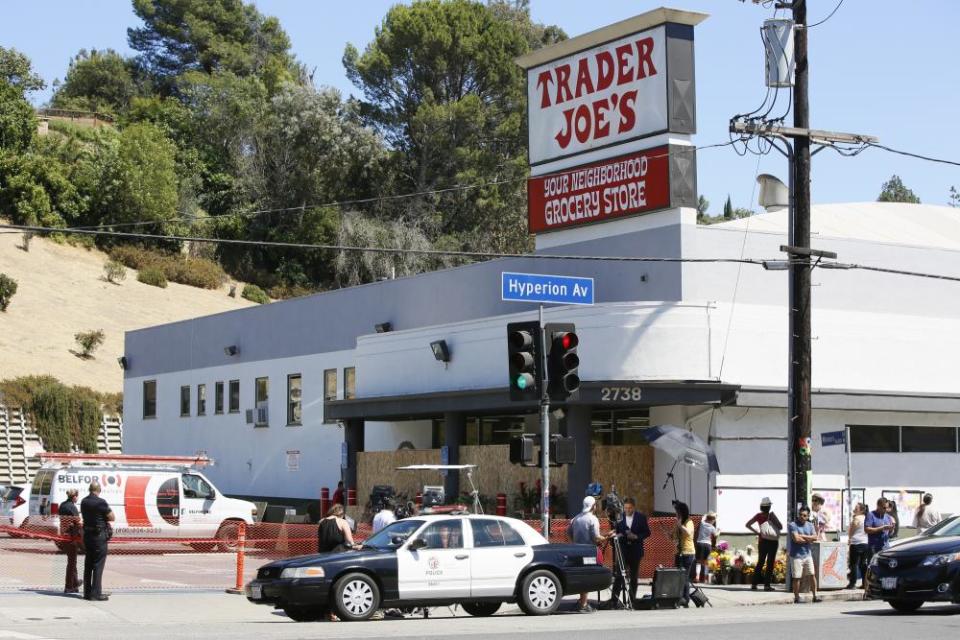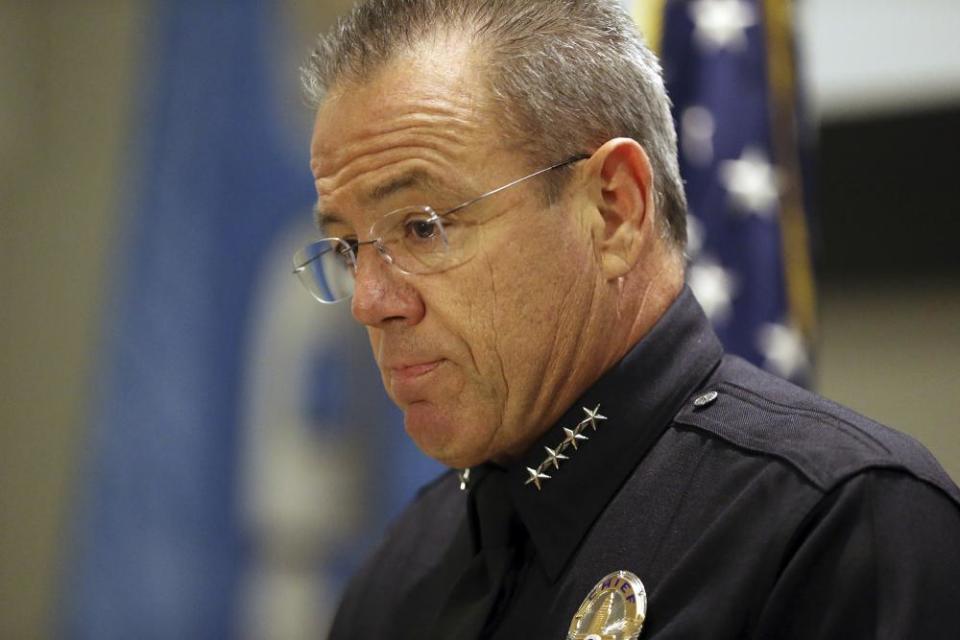A Trader Joe's shootout, an innocent death, and soul searching for LAPD
The tragic case of a woman killed in police crossfire has raised an uncomfortable question: did police do the right thing?

To shoot an innocent bystander in pursuit of a violent criminal is every police officer’s nightmare. In Los Angeles, with its vexed history of police brutality, racial tension, and high-speed car chases that local television networks feast on, it elicits a special sort of horror, a throwback to an ugly not-so-distant past that the city would much rather forget.
It has been just over a week since Melyda Corado, the young manager of a Trader Joe’s grocery store, was inadvertently killed by a police bullet. It happened after a fast-moving chase and shootout that took the police and their quarry through densely populated, affluent neighborhoods in and around Hollywood and culminated in a three-hour siege inside the store with 40 shoppers held hostage.
The man they were after, Gene Evin Atkins, was reported to have shot his grandmother multiple times and forced his 17-year-old girlfriend into the car with him. He kept firing his stolen handgun while driving at breakneck speed, shooting at the police and his girlfriend, who was found with a gunshot wound to her head after Atkins crashed into a telephone pole outside the Silver Lake Trader Joe’s. Atkins then ran inside.
Beyond the immediate drama, in a part of town jarringly unused to it, the episode has brought back all the uncomfortable old questions. Did the police do everything they could to protect the public, or did they in fact make a bad situation worse? Were they too quick to slam on the gas pedal? Did they shoot first and think through the consequences only afterwards, particularly since the suspect was African American? Are they willing, above all, to own their mistakes and learn from them?
The city’s new police chief, on the job for less than a month, has made multiple public appearances, released video footage from the pursuing police cruiser and the officers’ body cameras, and attempted the tricky balancing act of standing up for his department and while also promising a full and uncompromising investigation.
“It’s a lose-lose situation,” the chief, Michael Moore, told a radio interviewer. “If the officers don’t use deadly force and allow the gunman to continue, and he goes out and continues to shoot others, then the officers will be criticized for not using deadly force. If they use deadly force, and an innocent bystander as in this instance is tragically shot, the officers will be criticized for using deadly force.”

‘Why did they shoot at a busy store?’
Public opinion has been divided between those who think the police saved lives and those who believe the officers should never have opened fire at a grocery store on a Saturday afternoon. Many of those caught in the middle of the drama do not quite know what to think.
“My first reaction was, why did they shoot right at a busy store like that?” said Beth Murphy, who was half a block away with her five-year-old granddaughter when the gunfire started. “Then my family said maybe their training is to try to put him down so he doesn’t go in and shoot up the store.”
The cascade of events began with a violent dispute at a residence in an area of dilapidated single-storey houses and chain-link fences a mile south of downtown Los Angeles. It was Atkins’ family that reported he had shot his grandmother, grabbed his girlfriend and made off with the grandmother’s Toyota Camry.
The car was fitted with an anti-theft system that enabled the police to track it to Hollywood, five or six miles away. Police video shows officers catching up with the vehicle in a residential area nestled between Dodger Stadium and Griffith Park.
I hope that the LAPD will study every single detail of what happened here and draw what lessons they can
Jill Leovy, police reporter
At one point, Atkins shoots out his own back window. A female officer in the passenger seat, later identified by the police as Sarah Winans, tells her partner she has her gun ready.
“Do not, do not shoot,” her male partner at the wheel, Sinlen Tse, says. “We are going to keep our distance.”
The Camry’s movements become more erratic. The body camera shows the male officer’s hands trembling on the steering wheel. The Camry makes a desperate series of maneuvers to turn left at a major intersection, then careens across Hyperion Avenue before colliding with the telephone pole outside Trader Joe’s.
Atkins jumps out of his car, firing shots at the police, as he runs into the store. The officers take cover below their open patrol car doors, then run behind a low wall across the parking lot from the store entrance. The shooting continues, and the officers fire back. Their body cameras show that, for a few instants at least, they have a clear line of sight on the suspect, without cars or people. But then the cameras film only the wall where they are crouching, and it’s not clear who is shooting at what.
The LAPD says Atkins was gunning for the police before and after he entered the store. And at some point Corado, who’d been alerted by the sound of the Camry crashing, walked into the line of fire. A police bullet entered her left arm and from there into her body. She made it back to the manager’s desk before collapsing.

Atkins was shot too, also in the arm, and between the blood and the handgun he cut an alarming figure to shoppers in the crowded store. Some of them raced into a storage area, where a handful managed to escape through an open window. Atkins, according to eyewitness accounts, was vehement that he had not shot Corado and ordered everyone to stay put, but was otherwise relatively calm. His hostages took care to give him whatever he asked for – Jack Daniel’s to ease the pain in his arm, a T-shirt to mop up the blood, a cell phone to talk to an LAPD hostage negotiator.
When it became clear to Atkins that there was no way out of the impasse – the air was thick with helicopters and the police had the building surrounded – he and the LAPD haggled over the terms of his surrender. He agreed to wear a pair of police handcuffs if, in return, some of the hostages walked out in front of him so sharpshooters stationed on the roofs of adjacent buildings had no opportunity to pick him off.
He was taken safely into custody and charged with 31 criminal counts including murder, under a California law that holds a violent criminal responsible for a death that occurs as a result of his actions, even if he didn’t carry out the killing himself.
‘Not every police officer is a marksman’
A generation ago, an incident like this would have been kept much more closely under wraps. The police carried no body cameras, there were few mechanisms to force a public inquiry into controversial incidents, and the city leadership and local media tended to accept at face value whatever the police chose to say.
Since the riots of 1992, the culture of policing, and the city itself, has undergone a transformation. “Officer-involved shootings”, as they are known, have become much less common – although Los Angeles is still at or near the top of US cities for police killings of civilians. An independent, civilian-led police commission set up in the 1990s has pushed a succession of reforms, most recently a change in the department’s shooting policy to avert needless escalations of violence and a rule that all footage from body and dashboard cameras must be made public within 45 days unless the department can make a compelling case to withhold it for investigative reasons. LA’s mayor, Eric Garcetti, has called for “complete transparency” in this case, saying the public deserves answers.
Still, suspicion of the police runs high within civil rights and activist groups like Black Lives Matter, who have mobilized effectively in the wake of the 2014 police killing of an unarmed black man in south LA, Ezell Ford, and the 2015 killing of a black homeless man, Brendon Glenn, in Venice Beach.
Police reform experts said it was too soon to make hard judgments, but a number of turning points in the Gene Atkins pursuit are likely to come in for close examination. Among them:
Whether the police should have sent a patrol car after Atkins at all, since they could track his movements through the LoJack system; they could, for example, have tracked him by helicopter and picked him up when it was safer to do so.
Whether it was smart to return Atkins’ fire outside Trader Joe’s – even if returning fire is technically within department policy.
Whether, conversely, the fact that he was shot and wounded made him more docile and less dangerous to the shoppers trapped inside the store.

“How do you handle a hostage situation without accidentally killing hostages?” asked Jill Leovy, a former police reporter for the Los Angeles Times and author of Ghettoside, an acclaimed study of how poor practices and under-policing in blighted neighborhoods go hand in hand with violence. “This is about training and tactics and how to minimize injury in a fast-moving situation. It’s about knowing that you have a clear shot, knowing what’s in the background and periphery of the shot. It’s about making difficult snap judgments and worrying that if the guy goes into a store full of people he’s going to massacre those people.
“These kinds of questions are the real stuff … I certainly hope that the LAPD will study every single detail of what happened here and not just react appropriately but draw what lessons they can.”
Frank Straub, an expert in assessing major incidents with the national Police Foundation, said that while it was possible to second-guess the LA police, he believed the officers acted as best they could in a fluid and unpredictable situation. “We all feel horribly that an in innocent person was struck. Nobody wants that to happen,” he said. “They are trained and taught to end the threat, and they saw a definite need to prevent him entering the store and taking hostages…
“Unfortunately, people move during these interactions. And not every police officer is a marksman.”
Since the incident, the Silver Lake Trader Joe’s has been boarded up and sealed off with plastic fencing and it is far from clear when it will reopen. The wall along Hyperion Avenue has become a shrine to Corado, thick with flowers and candles and notes and letters from her friends, family, customers, and countless strangers. A banner reads: “All for Love, Love for All.”
“That poor girl,” remarked Beth Murphy. “It’s such a shame, just tragic.”
This article was amended on 31 July 2018 to correct Frank Straub’s title.

